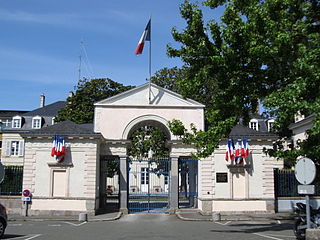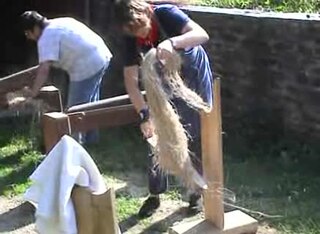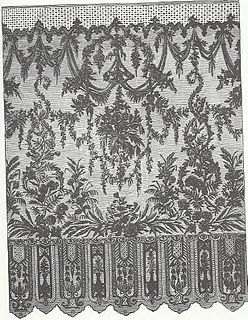
Flax, also known as common flax or linseed, is a flowering plant, Linum usitatissimum, in the family Linaceae. It is cultivated as a food and fiber crop in regions of the world with temperate climate. Textiles made from flax are known in Western countries as linen, and are traditionally used for bed sheets, underclothes, and table linen. Its oil is known as linseed oil. In addition to referring to the plant itself, the word "flax" may refer to the unspun fibers of the flax plant. The plant species is known only as a cultivated plant, and appears to have been domesticated just once from the wild species Linum bienne, called pale flax. The plants called "flax" in New Zealand are, by contrast, members of the genus Phormium.

Linen is a textile made from the fibers of the flax plant.

Textile arts are arts and crafts that use plant, animal, or synthetic fibers to construct practical or decorative objects.

Mayenne is a department in northwest France named after the Mayenne River. Mayenne is part of the current region of Pays de la Loire and is surrounded by the departments of Manche, Orne, Sarthe, Maine-et-Loire, and Ille-et-Vilaine.

New Zealand flax describes the common New Zealand perennial plants Phormium tenax and Phormium colensoi, known by the Māori names harakeke and wharariki respectively. Although given the common name 'flax' they are quite distinct from the Northern Hemisphere plant known as flax

Foxton is a town in the Manawatū-Whanganui region of New Zealand - on the lower west coast of the North Island, in the Horowhenua district, 30 km (19 mi) southwest of Palmerston North and just north of Levin. The town is located close to the banks of the Manawatu River. It is situated on State Highway 1, roughly in the middle between Tongariro National Park and Wellington.

Linum (flax) is a genus of approximately 200 species in the flowering plant family Linaceae. They are native to temperate and subtropical regions of the world. The genus includes the common flax, the bast fibre of which is used to produce linen and the seeds to produce linseed oil.

Irish linen is the brand name given to linen produced in Ireland. Linen is cloth woven from, or yarn spun from the flax fibre, which was grown in Ireland for many years before advanced agricultural methods and more suitable climate led to the concentration of quality flax cultivation in northern Europe. Since about the 1950s to 1960s the flax fibre for Irish linen yarn has been, almost exclusively, imported from France, Belgium and the Netherlands. It is bought by spinners who produce yarn and this, in turn, is sold to weavers who produce fabric. Irish linen spinning has now virtually ceased, yarns being imported from places such as the Eastern part of the European Union and China.
The United Nations General Assembly declared 2009 as the International Year of Natural Fibres (IYNF), as well as the International Year of Astronomy.
Kenneth Flax is a retired American Olympic hammer thrower, whose personal best throw is 80.02 metres, achieved in May 1988 in Modesto.

Hesperolinon is a genus in the family Linaceae, whose common genus names are dwarf-flax or western flax, in reference to their distribution along the west coast of North America. There are 13 known species within this genus of wildflowers, most of which are limited to serpentine soil habitats within California, United States. These annual plants are thought to be mostly self-pollinating.

Ditherington Flax Mill, a flax mill located in Ditherington, a suburb of Shrewsbury, England, is the first iron-framed building in the world, and described as "the grandfather of skyscrapers", despite its five-storey height. Its importance was officially recognised in the 1950s, resulting in it becoming a Grade I listed building. It is also locally known as the "Maltings" from its later use.

Māori traditional textiles are the indigenous textiles of the Māori people of New Zealand. The organisation Te Roopu Raranga Whatu o Aotearoa, the national Māori weavers' collective, aims to preserve and foster the skills of making and using these materials.

Muka is prepared fibre of New Zealand flax. Prepared primarily by scraping, pounding and washing, it is a key material in Māori traditional textiles where it is usually used in tāniko or twined weaving.

Scutching is a step in the processing of cotton or the dressing of flax or hemp in preparation for spinning. The scutching process separates the impurities from the raw material, such as the seeds from raw cotton or the straw and woody stem from flax fibers. Scutching can be done by hand or by a machine known as a scutcher. Hand scutching of flax is done with a wooden scutching knife and a small iron scraper. The end products of scutching flax are the long finer flax fibers called line, short coarser fibers called tow, and waste woody matter called shives.

Alexander Henry Flax was the Chief Scientist of the U.S. Air Force (USAF) from 1959 to 1961, Assistant Secretary of the Air Force for Research and Development from 1963 to 1969, and the third Director of the National Reconnaissance Office (NRO) from 1965 to 1969. He was the director at a time when the second generation of imaging systems became operational and began to play a major role in United States intelligence during the Cold War. He oversaw major growth in NRO funding and personnel, the development of signals intelligence collectors from space, and the development of electro-optical imaging for US reconnaissance satellites.

Shades of white are colors that differ only slightly from pure white. Variations of white include what are commonly termed off-white colors, which may be considered part of a neutral color scheme.

Egg substitutes are food products which can be used to replace eggs in cooking and baking. Usual reasons for choosing them instead of eggs include egg allergy, vegan diet, and vegetarian diets of types that omit eggs. They also can be used by people who eat meat and eggs but are not willing to buy animal products produced with insufficient animal welfare and cannot afford, cannot find, or do not trust the labeling of eggs labeled as being humanely produced.

Bayeux lace was bobbin lace that was made at Bayeux in Normandy, France.
















